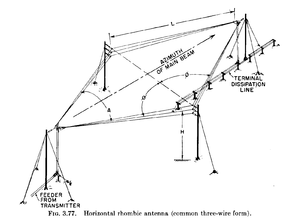- Rhombic antenna
-
 Rhombic antenna signal-gathering action compared to other end-fire, backfire and traveling-wave types.
Rhombic antenna signal-gathering action compared to other end-fire, backfire and traveling-wave types.A rhombic antenna is a broadband directional antenna co-invented by Edmond Bruce and Harald Friis,[1] mostly commonly used in HF (high frequency, also called shortwave) ranges.
Contents
Technical Detail
It is named after its "rhombic" diamond shape, with each side typically at least one wavelength (λ) or longer in length. Each vertex is supported by a pole, typically at least one wavelength high. A horizontal rhombic antenna (picture below) radiates horizontally polarised waves. Its principal advantages over other choices of antenna are its simplicity, high forward gain and the ability to operate over a wide range of frequencies.
It is typically fed at one of the two sharper angles through a balanced transmission line. Less commonly, it can be fed with coaxial cable through a balun transformer. The opposite end is either left open for bi-directional use, or terminated at the opposite sharp angle with a non-inductive resistor. It is directional towards the resistor end, so the termination end points towards the region of the world it is designed to serve. Even when unterminated (bi-directional) the rhombic is not perfectly bi-directional. This is because of losses in the system primarily caused by radiation, conductor resistance, and coupling to the lossy soil below the antenna.
The rhombic antenna, like other horizontal antennas, can radiate at elevation angles close to the horizon or at higher angles depending on its height above ground relative to the operating frequency and its physical construction. Likewise, its beam can be narrow or broad, depending primarily on its length. A proper combination of size, height, and operating frequency make it fit for medium or long range communication.
A rhombic requires a large area of land — especially if several antennas are installed to serve a variety of geographic regions at different distances or directions or to cover widely different frequencies. The rhombic suffers from efficiency problems due to earth losses below the antenna, significant power-wasting spurious lobes, termination losses, and the inability to maintain constant current along the length of the conductors. Typical radiation efficiency is in the order of 40-50%. The low efficiency significantly reduces gain for a given main lobe beamwidth when compared to other arrays of the same beamwidth.[2]
At the expense of system simplicity, it is possible to improve efficiency by recirculation of power wasted in the termination resistance of unidirectional rhombics. Use of a recirculating termination system can move efficiency into the 70-80% range by combining power that would have been wasted in the termination with the transmitter power. Such systems bring a low-loss balanced line back from the termination end to the feedpoint through a matching and phasing system. Energy that would otherwise dissipated in the termination resistance is applied in-phase with the excitation.
Prior to WWII, the rhombic was one of the most popular point-to-point high frequency antenna arrays. After WWII the rhombic largely fell out of favor for shortwave broadcast and point-to-point communications work, being replaced by log periodics and curtain arrays. Larger log periodics provide wider frequency coverage with comparable gain to rhombics. Distributed feed curtains or HRS curtain arrays provided a cleaner pattern, ability to steer the pattern in elevation and azimuth, much higher efficiency, and significantly higher gain in less space. However, rhombic antennas are used in cases where the combination of high forward gain (despite the losses described above) and large operating bandwidth cannot be achieved by other means.
The rhombic remains one of the least complex medium-gain options for sustained long distance communications over point-to-point circuits. Rhombics also handle considerable transmitter power, since they have essentially uniform voltage and current distribution. The rhombic's low cost, simplicity, reliability, and ease of construction sometimes outweighs performance advantages offered by other more complex arrays.[3][4][5]
Advantages of Rhombic Antennas
- Its input impedance & radiation pattern are relatively constant over a 2:1 range of frequencies. Its impedance can be made relatively constant over a frequency range 4:1 or more, with the forward gain increasing at 6 dB per octave.
- Multiple rhombic antennas can be connected in an end-to-end fashion to form MUSA (Multiple Unit Steerable Antenna). MUSA arrays can receive long distance, short wave, horizontally polarized down coming waves.
- In addition to its use as a simple and effective transmitting antenna (as described above), the rhombic can also be used as an HF receiving antenna with good gain and directivity. For example, BBC Monitoring's Crowsley Park receiving station has three rhombic antennas aligned for reception at azimuths of 37, 57 and 77 degrees.
Patents
References
- ^ Harald T. Friis at IEEE GHN.org http://www.ieeeghn.org/wiki/index.php/Harald_T._Friis
- ^ Antennas and Transmission Lines, J. Kuecken
- ^ Electromagnetic Waves and Radiating Systems, Jordon-Balmain,Prentice-Hall EE Series,2nd edition
- ^ Antennas,J. Kraus, McGraw-Hill EE series, pgs 408-412
- ^ Radio Antenna Engineering, E.A, Laport, McGraw-Hill, 1952, pp. 315-334
Antenna types Isotropic Omnidirectional Coaxial antenna · Dipole antenna · Discone antenna · Folded unipole antenna · Ground-plane antenna · Halo antenna · Helical antenna · J-pole antenna · Mast radiator · Monopole antenna · Random wire antenna · Rubber Ducky antenna · T2FD Antenna · Whip antennaDirectional AWX antenna · Beverage antenna · Cantenna · Collinear antenna · Fractal antenna · Ground dipole · Helical antenna · Horizontal curtain · Horn · Inverted vee antenna · Log-periodic antenna · Loop antenna · Microstrip antenna · Patch antenna · Phased array · Parabolic antenna · Plasma antenna · Quad antenna · Reflective array antenna · Regenerative loop antenna · Rhombic antenna · Sector antenna · Short backfire antenna · Slot antenna · Turnstile antenna · Vivaldi-antenna · Yagi-Uda antennaApplication-specific Categories:- Radio frequency antenna types
Wikimedia Foundation. 2010.

